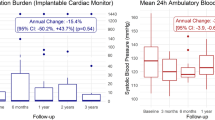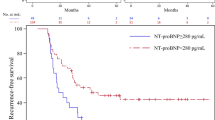Abstract
Purpose
The effects of radio-frequency ablation (RFA) on blood pressure (BP) regulation in patients with atrial fibrillation (AF) and hypertension remain unknown. We hypothesized that patients with successful ablation had a lower BP and/or lesser utilization of antihypertensive drug therapy during follow-up when compared to patients with failed ablation.
Methods and results
This was a retrospective evaluation of patients with AF and hypertension treated with ablation at the University of Utah between July 2006 and June 2010. BP and use of antihypertensive medications were assessed at baseline and 1 year follow-up. A total of 167 patients were identified. Eight patients were excluded due to the need for AAD therapy beyond the blanking period thus leaving 80 patients in the success group and 79 patients in the failure group. The mean BP and HR at baseline were not significant between the groups. In the success group, the mean systolic BP decreased from a baseline value of 129 ± 17 to 125 ± 14 mmHg at 1 year (p = 0.075). In contrast, in the failure group, the mean systolic BP increased from a baseline value of 124 ± 16 to 127 ± 14 mmHg at 1 year (p = 0.176). Between-group comparison revealed a p value of 0.026. Minimal changes in diastolic BP were noted in both groups. No significant changes in antihypertensive therapy were noted.
Conclusion
We have shown that successful catheter ablation in patients with AF and hypertension is associated with a decrease in systolic BP when compared to an increase in patients with failed ablation. Our findings suggest that restoring sinus rhythm could have an antihypertensive effect in patients with AF and hypertension.


Similar content being viewed by others
References
Go, A. S., Hylek, E. M., Phillips, K. A., Chang, Y., Henault, L. E., Selby, J. V., et al. (2001). Prevalence of diagnosed atrial fibrillation in adults: national implications for rhythm management and stroke prevention: the AnTicoagulation and Risk Factors in Atrial Fibrillation (ATRIA) Study. Journal of the American Medical Association, 285(18), 2370–2375.
Nieuwlaat, R., Capucci, A., Camm, A. J., Olsson, S. B., Andresen, D., Davies, D. W., et al. (2005). Atrial fibrillation management: a prospective survey in ESC member countries: the Euro Heart Survey on Atrial Fibrillation. European Heart Journal, 26(22), 2422–2434.
Wilber, D. J., Pappone, C., Neuzil, P., De Paola, A., Marchlinski, F., Natale, A., et al. (2010). Comparison of antiarrhythmic drug therapy and radiofrequency catheter ablation in patients with paroxysmal atrial fibrillation: a randomized controlled trial. Journal of the American Medical Association, 303(4), 333–340.
Benjamin, E. J., Levy, D., Vaziri, S. M., D’Agostino, R. B., Belanger, A. J., & Wolf, P. A. (1994). Independent risk factors for atrial fibrillation in a population-based cohort. The Framingham Heart Study. Journal of the American Medical Association, 271(11), 840–844.
Lau, D. H., Mackenzie, L., Kelly, D. J., Psaltis, P. J., Brooks, A. G., Worthington, M., et al. (2010). Hypertension and atrial fibrillation: evidence of progressive atrial remodeling with electrostructural correlate in a conscious chronically instrumented ovine model. Heart Rhythm, 7(9), 1282–1290.
Medi, C., Kalman, J. M., Ling, L. H., Teh, A. W., Lee, G., Spence, S. J., et al. (2012). Atrial electrical and structural remodeling associated with longstanding pulmonary hypertension and right ventricular hypertrophy in humans. Journal of Cardiovascular Electrophysiology, 23, 614–620
Medi, C., Kalman, J. M., Spence, S. J., Teh, A. W., Lee, G., Bader, I., et al. (2011). Atrial electrical and structural changes associated with longstanding hypertension in humans: implications for the substrate for atrial fibrillation. Journal of Cardiovascular Electrophysiology, 22(12), 1317–1324.
Psaty, B. M., Manolio, T. A., Kuller, L. H., Kronmal, R. A., Cushman, M., Fried, L. P., et al. (1997). Incidence of and risk factors for atrial fibrillation in older adults. Circulation, 96(7), 2455–2461.
Masood, S. O., Wasmund, S. L., Akoum, N. W., Egger, M. J., Hsiai, T., & Hamdan, M. H. (2010). The effects of rate and rhythm control on blood pressure and antihypertensive drug usage in patients with atrial fibrillation and hypertension enrolled in the AFFIRM trial. Journal of Cardiovascular Electrophysiology, 21(10), 1094–1098.
Sanders, N. A., Bertolone, C., Jetter, T. L., Wasmund, S. L., Croci, F., Solano, A., et al. (2012). Restoring sinus rhythm results in blood pressure reduction in patients with persistent atrial fibrillation and a history of hypertension. Journal of Cardiovascular Electrophysiology, 23, 722–726
Segerson, N. M., Daccarett, M., Badger, T. J., Shabaan, A., Akoum, N., Fish, E. N., et al. (2010). Magnetic resonance imaging-confirmed ablative debulking of the left atrial posterior wall and septum for treatment of persistent atrial fibrillation: rationale and initial experience. Journal of Cardiovascular Electrophysiology, 21(2), 126–132.
Calkins, H., Brugada, J., Packer, D. L., Cappato, R., Chen, S. A., Crijns, H. J., et al. (2007). HRS/EHRA/ECAS expert Consensus Statement on catheter and surgical ablation of atrial fibrillation: recommendations for personnel, policy, procedures and follow-up. A report of the Heart Rhythm Society (HRS) Task Force on catheter and surgical ablation of atrial fibrillation. Heart Rhythm, 4(6), 816–861.
Wyse, D. G., Anderson, J. L., Antman, E. M., Cooper, E. S., Dalquist, J. E., Davis, K. B., et al. (1997). Atrial fibrillation follow-up investigation of rhythm management—the AFFIRM study design. The Planning and Steering Committees of the AFFIRM study for the NHLBI AFFIRM investigators. American Journal of Cardiology, 79(9), 1198–1202.
ALLHAT Officers and Coordinators for the ALLHAT Collaborative Research Group, The Antihypertensive and Lipid-Lowering Treatment to Prevent Heart Attack Trial. (2002). Major outcomes in high-risk hypertensive patients randomized to angiotensin-converting enzyme inhibitor or calcium channel blocker vs diuretic: The Antihypertensive and Lipid-Lowering Treatment to Prevent Heart Attack Trial (ALLHAT). Journal of the American Medical Association, 288(23), 2981–2997.
Boldt, A., Wetzel, U., Weigl, J., Garbade, J., Lauschke, J., Hindricks, G., et al. (2003). Expression of angiotensin II receptors in human left and right atrial tissue in atrial fibrillation with and without underlying mitral valve disease. Journal of the American College of Cardiology, 42(10), 1785–1792.
Dixen, U., Ravn, L., Soeby-Rasmussen, C., Paulsen, A. W., Parner, J., Frandsen, E., et al. (2007). Raised plasma aldosterone and natriuretic peptides in atrial fibrillation. Cardiology, 108(1), 35–39.
Goette, A., Staack, T., Rocken, C., Arndt, M., Geller, J. C., Huth, C., et al. (2000). Increased expression of extracellular signal-regulated kinase and angiotensin-converting enzyme in human atria during atrial fibrillation. Journal of the American College of Cardiology, 35(6), 1669–1677.
Takahashi, N., Ishibashi, Y., Shimada, T., Sakane, T., Ohata, S., Sugamori, T., et al. (2002). Impaired exercise-induced vasodilatation in chronic atrial fibrillation—role of endothelium-derived nitric oxide. Circulation Journal, 66(6), 583–588.
Segerson, N. M., Sharma, N., Smith, M. L., Wasmund, S. L., Kowal, R. C., Abedin, M., et al. (2007). The effects of rate and irregularity on sympathetic nerve activity in human subjects. Heart Rhythm, 4(1), 20–26.
Wasmund, S. L., Li, J. M., Page, R. L., Joglar, J. A., Kowal, R. C., Smith, M. L., et al. (2003). Effect of atrial fibrillation and an irregular ventricular response on sympathetic nerve activity in human subjects. Circulation, 107(15), 2011–2015.
Author information
Authors and Affiliations
Corresponding author
Additional information
Editorial commentary
This manuscript retrospectively evaluates the effects of radio-frequency ablation on BP regulation in hypertensive patients undergoing atrial fibrillation (AF) radio-frequency ablation. In the group with a successful ablation, the mean systolic BP had a trend decrease from a baseline value of 129 ± 17 to 125 ± 14 mmHg at 1 year (p = 0.075). Versus in those with a failed ablation, the mean systolic BP trend increased from a baseline value of 124 ± 16 to 127 ± 14 mmHg at 1 year (p = 0.176). Minimal changes in diastolic BP were noted in both groups. No significant changes in antihypertensive therapy were noted. The authors conclude that successful catheter ablation in patients with AF and hypertension is associated with a decrease in systolic BP when compared to an increase in patients with failed ablation. These preliminary findings suggest that restoring sinus rhythm could have an antihypertensive effect in patients with AF and hypertension.
Rights and permissions
About this article
Cite this article
Ramirez, A., Pacchia, C.F., Sanders, N.A. et al. The effects of radio-frequency ablation on blood pressure control in patients with atrial fibrillation and hypertension. J Interv Card Electrophysiol 35, 285–291 (2012). https://doi.org/10.1007/s10840-012-9716-z
Received:
Accepted:
Published:
Issue Date:
DOI: https://doi.org/10.1007/s10840-012-9716-z




